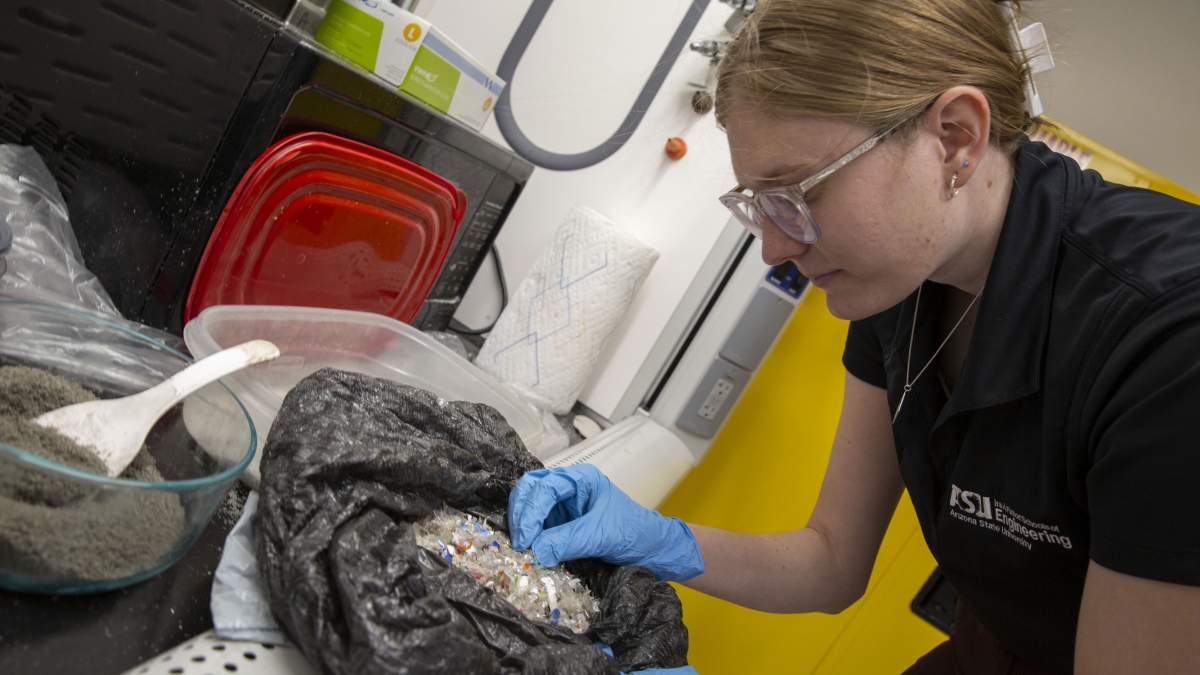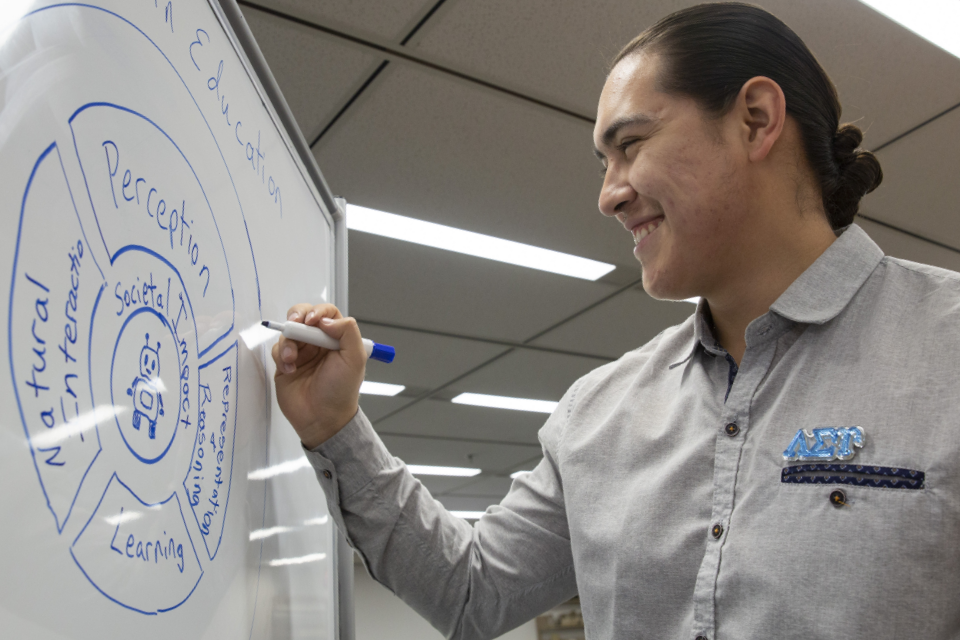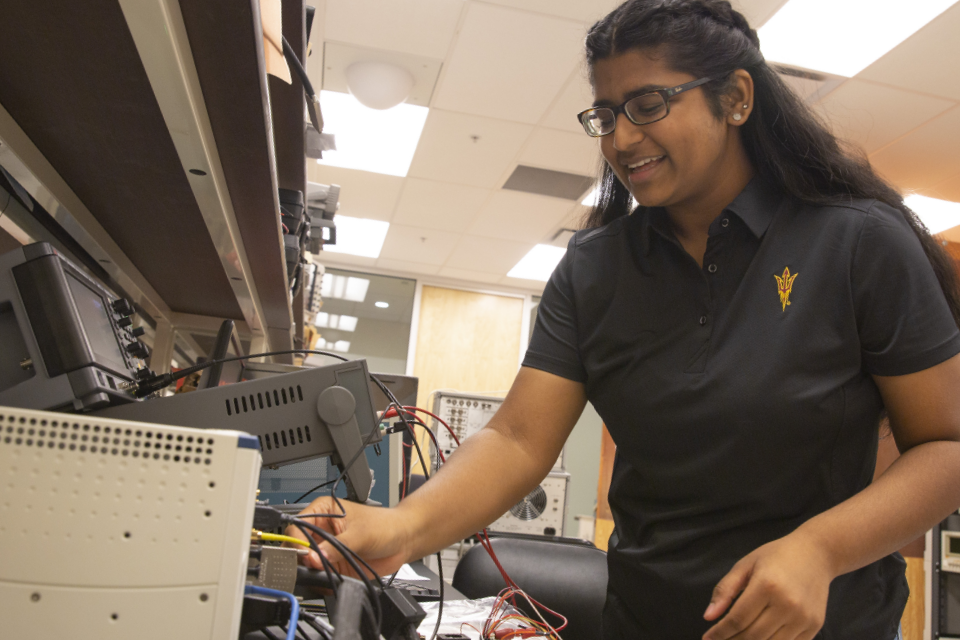Editor's note: This story originally appeared in the summer 2023 issue of ASU Thrive magazine.
Some students say they chose ASU so they could work on real-world research with faculty who are top in their fields. Whether in engineering, sustainability, pre-med, veterinary science, physics, space or any number of fields, university students can get involved in solving problems early.
Here, three graduating seniors discuss their projects, from artificial intelligence in K–12 to more sustainable cement to a new circuit that uses less energy and computes faster, and why they matter and how these opportunities set them up for success on their next journeys.
Susanna Westersund, making concrete more sustainable
Graduating civil, environmental and sustainable engineering student Susanna Westersund worked on a project aimed to make concrete more sustainable while also reducing plastic pollution.
As Westersund points out, the environment faces the overaccumulation of plastics. Additionally, “concrete production is one of the leading causes of carbon dioxide emissions in the atmosphere, so replacing some of the cement with plastic particles is better for the environment,” she says.
Westersund’s project as part of the Fulton Undergraduate Research Initiative built on the work already done to alter and treat polyethylene plastic to add to cement mixtures.
“I chose this project because I am interested in the sustainable materials that can be used in civil engineering,” Westersund says. “The biggest thing I have noticed since being in this program is that I now see applications of things I am learning in my classes.”
In addition, the project helped her gain experience collaborating with other team members in labs. “When I go into job interviews, I have the ability to talk about my project and how I have applied myself outside of class,” Westersund says.
Working with her faculty mentor, Christian Hoover, an assistant professor in the School of Sustainable Engineering and the Built Environment, proved invaluable, she says. In 2022, Hoover won the National Science Foundation Faculty Early Career Development Program Award, which comes with $600,000 in funding to pursue research. Westersund says she gained confidence in herself and her abilities as an engineer while conducting research under Hoover.
“One of the best pieces of advice I have gotten from my mentor Professor Hoover is to trust in my abilities,” Westersund says.
She encourages students to engage with research opportunities at ASU. “I have met many different faculty members and students who have given me connections, and I have learned about other projects, as well,” she says.
Jose Gonzalez-Garduno, researching ways for AI to benefit K–12 education
Jose Gonzalez-Garduno focused on researching ways for AI to benefit K–12 education.
Over the course of the fall 2022 semester, Jose Gonzalez-Garduno, a graduating senior in the Ira A. Fulton Schools of Engineering computer science program, developed a project to explore how AI technologies in K–12 classrooms can benefit both students and educators.
“AI isn’t just changing how STEM courses are being taught in school — it’s changing the whole education sector and how it operates,” Gonzalez-Garduno says.
He and other students accepted into one of ASU’s research opportunities, the Lincoln Center research program, shape their projects through close consultation with Erica O’Neil, center research program manager whose guidance Gonzalez-Garduno called “inspiring.”
Gonzalez-Garduno’s path started back when he began at community college in order to gather credits before transferring to ASU in fall 2019, where he became a student in Barrett, The Honors College. While maintaining high grades and carrying out real-world research, he also worked full time for five years in order to help support himself and his family.
A focus of his research so far has been how to use AI applications in K–12 classrooms so that technologies act like an interactive tool that enhances human capacities, Gonzalez-Garduno says.
“Research in intelligent tutoring systems investigates things like gamification, such as completing challenges to earn prizes or achievements. These different types of motivations can further students’ development and ultimately have a positive impact,” Gonzalez-Garduno explains. “Unfortunately, it starts becoming a problem in regard to how privacy is handled.
“My current research is looking at these two components, and whether the positives outweigh negatives, and how these improvements can help further the education field and how students benefit from it.”
What’s next?
He plans to go on to a master’s program in computer science, and hopefully also to earn his PhD.
“It’s going to be a whole new journey for me as a first-generation college student,” Gonzalez-Garduno says. “I’m also looking forward to getting a job as a software developer and seeing the difference that I can make within these tech companies by seeing how we can create new technologies that positively impact society.”
Sritharini Radhakrishnan, testing a circuit component that retains memory without power
Sritharini Radhakrishnan tested a circuit component that retains memory without power.
Graduating electrical engineering senior Sritharini Radhakrishnan has been working to improve neuromorphic computing, which tries to mimic the brain’s use of neurons and synapses. Conversely, traditional computing, sometimes called von Neumann computing, uses separate CPUs and memory units. Brain-inspired computing more closely mimics the structure of the human brain, in which memory and “processing” are combined. This structure can drive advances in machine learning and AI by building more energy-efficient, scalable and adaptive computer systems, Radhakrishnan says.
Her work tested a certain type of memristor, a new type of electric circuit component that retains memory even without power. It is part of ongoing research that seeks to find out if hexagonal boron nitride, a layered 2D material, proves promising for implementing brain-inspired circuits.
“Everyone in the field aims to advance neuromorphic computing to the point that any device using the current von Neumann computing architecture can be replaced with a neuromorphic one. To achieve such a goal, it is vital to show that the neuromorphic computing scheme is competitive with the von Neumann one by demonstrating that neuromorphic circuits can carry out complex operations faster and with greater efficiency,” Radhakrishnan says.
By investigating the performance of hexagonal boron nitride for memristor devices, Radhakrishnan hopes to make this next-generation computing architecture a reality for data-hungry applications that current systems struggle to do efficiently.
Radhakrishnan says she is excited to have worked on a “truly cutting-edge” field that will impact the computing systems humanity needs to solve complex problems.
“By working on this research as an undergrad, I was able to get a head start in gaining technical know-how and experience to significantly contribute to any engineering research in my career,” she says.
Get involved as a student
• Find out about numerous research opportunities for students at provost.asu.edu/uresearch.
• Learn more about the Fulton Undergraduate Research Initiative at furi.engineering.asu.edu.
• Check out opportunities at Lincoln Center for Applied Ethics at lincolncenter.asu.edu.
Story by Monique Clement, ’09 BA, and Karina Fitzgerald, ’18 BA, ’20 MA. Photos by Erika Gronek, ’97 BA, ’03 BA.
Top photo: Susanna Westersund makes concrete more sustainable.
More Science and technology

Hack like you 'meme' it
What do pepperoni pizza, cat memes and an online dojo have in common?It turns out, these are all essential elements of a great cybersecurity hacking competition.And experts at Arizona State…

ASU professor breeds new tomato variety, the 'Desert Dew'
In an era defined by climate volatility and resource scarcity, researchers are developing crops that can survive — and thrive — under pressure.One such innovation is the newly released tomato variety…

Science meets play: ASU researcher makes developmental science hands-on for families
On a Friday morning at the Edna Vihel Arts Center in Tempe, toddlers dip paint brushes into bright colors, decorating paper fish. Nearby, children chase bubbles and move to music, while…




